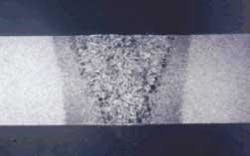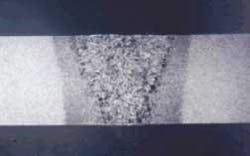Laser welding beyond limits
Laser welding is used in numerous industrial applications ranging from aircraft stringers to tailored blanks and even ship panels. The technology of CO2 and Nd:YAG laser deep-penetration welding has been studied and understood for some time. Basically, it requires a certain intensity to generate a keyhole and deeply penetrate the material. Gases are required to shield the heated material against the effect of air, as in classical welding procedures. The plasma formation in CO2 laser welding still represents a slight technology challenge although counter-measures such as helium additions in the welding gas are well known.
We know the pros and cons and the most economical applications of the new lasers, such as the disc laser, diode laser and fiber laser. Diode lasers, for example, offer a large-size spot that is good for surface heating and remelting but is not suitable for cutting and welding due to the lack of intensity in the spot. But, are we sure?
How can we explain the cross-section in Figure 1, which shows a 3kW diode laser weld in 3mm-thick mild steel produced under industrially acceptable parameters? High-speed videos made at the same time clearly show the formation of a keyhole. How does this happen?
CO2 does the trick
CO2 as a welding gas is well known from classical welding techniques. It dissociates in the electric arc and recombines on the surface, transferring much of the heat energy picked up in the dissociation process, thus affecting the viscosity and surface tension of the melt. Compared to oxygen CO2 is much more difficult to decompose, requiring higher temperatures (see Figure 2). Oxygen starts to decompose with increasing temperature whereas CO2 remains stable until approximately 2000 K, the range for melting/welding steel. Therefore, only a few percent of the oxygen radicals are active at steel melting temperatures with CO2 compared to more than 75 percent oxygen radicals with pure oxygen. Consequently, almost no oxygen or carbon pick-up could be detected with CO2 additions to the welding gas.
Melt pool flow
So, what happens in the melt pool? Marangoni says that surface tensions and shear tensions are the driving forces in the melt pool directing the melt flow. Because the temperature gradient at the melt surface becomes smaller towards the pool edges, shear tensions are generated by temperature-driven surface tensions. These surface tensions may increase or decrease with rising temperature and thus steer the direction of melt flow. Elements influencing the gradient of the surface tensions include sulfur and oxygen. Figure 3 indicates the effect of small amounts of oxygen on the surface tensions. Surface tensions of iron decrease with raising temperatures, as can be seen. This is different with oxygen being dissolved in the metal. As you can see from the curves with 0.009 and 0.018 percent oxygen dissolved in the metal, the surface tensions are smaller at lower temperatures compared to the oxygen-free iron but surface tensions increase with raising temperatures. Consequently, sheer tensions and thus melt flow direction are affected.
Convection and deep-penetration welding
Surface tension drives melt flow in the pool. In diode laser welding, the melt normally flows from the center of the spot towards the pool's edges. Adding CO2 to the welding gas, thereby adding oxygen to the weld metal at the same time, can change this direction of flow. The melt then flows from the outside towards the center, where it concentrates energy input.
Consequently, the temperature in the center is increased and metal vapor leaves the keyhole due to the vapor pressure in the keyhole and forms a vapor plume. In addition, the crater at the end of weld indicates a change from convection mode welding towards keyhole welding.
Changing the melt flow direction
Figure 4 shows how a change in melt flow affects penetration depth by simply increasing the amount of CO2 in the welding gas starting from pure inert gas. A proper balance of CO2 and inert gases provides a suitable penetration depth and good blanketing of the weld, with not enough oxygen to oxidize the material. Pure oxygen, on the other hand, would result in too many free oxygen radicals, thereby compromising material properties and seam appearance.
Additionally, high-speed photos have been made to verify and understand these melt flow motions. Particles with high melting points were distributed on the plate material in order to visualize the motions of these particles and the enclosed motions of the melt pool during welding with different process gases. Those high-speed photos clearly show a change in the melt flow direction with active gas components towards the center of the pool and downwards towards the root side.
New applications
Tests show the extraordinary effect of the welding gas composition on the performance of a high-power diode laser. Active additions such as CO2 to the welding gas cause a change in the direction of melt flow with a switch from conduction mode to deep penetration welding happening at the same time. Deep and narrow seams can be produced with a laser technology that has not yet reached the ultimate stage of its development. Adapted process gases from the Linde AG (Munich, Germany) Laserline program increase efficiency and economy of high-power diode laser welding, opening up new applications for tomorrow's technology.
Mark Faerber and Wolfgang Danzer are with Linde AG, Munich, Germany, Johann Härtl is with IWB, Munich, Germany. Contact Linde/.AGA USA at ph. ++1-877-481-0821, and please ask for the Laserline program.




